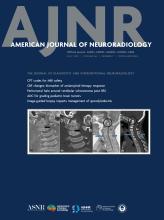Case of the Month
Section Editor: Nicholas Stence, MD
Children's Hospital Colorado, Aurora, CO
June 2022
Next Case of the Month Coming July 5...
Caroticocavernous Fistula
- Hospital Course:
- Because the patient presented with bilateral (R>L), asymmetric ocular complaints in the form of redness, proptosis, and excessive lacrimation, caroticocavernous fistula (CCF) was the most favored diagnostic consideration.
- Color Doppler examination confirmed dilated SOVs with flow reversal and arterialized flow. Ophthalmology work-up also confirmed raised intraocular pressures.
- In the presence of typical MRI findings of AV shunting in the cavernous sinus region on ASL perfusion images, asymmetric brainstem T2/FLAIR hyperintensity associated with scattered foci of hemorrhagic blooming, and patchy parenchymal as well as perivascular enhancement in the posterior fossa, the possibility of secondary venous hypertension was favored over neuroinflammatory and neoplastic etiologies.
- Diagnostic subtraction angiography confirmed the left-sided indirect CCF with arterial feeders from bilateral ICA (meningohypophyseal trunk), bilateral MMA (cavernous branches), and terminal branches of bilateral IMA. Venous drainage was noted anteriorly along the dilated right SOV and posteriorly along right superior and inferior petrosal sinuses. Reflux was also noted across intercavernous communication to the right cavernous sinus, dilated right SOV, and right superior and inferior petrosal sinuses. Furthermore, venous reflux was demonstrated into tortuous, prominent posterior fossa veins, confirming secondary venous hypertension in the infratentorial compartment.
- The patient subsequently underwent transvenous coiling along with Squid embolization of the left cavernous sinus, achieving complete obliteration of fistulous communication. Postprocedure, the patient reported gradual improvement in ocular symptoms and was discharged in stable condition.
- Background:
- CCF is an acquired vascular malformation resulting from an abnormal communication between the cavernous sinus (CS) located at the skull base with either the internal carotid artery directly (direct CCF) or with dural branches of the internal or external carotid arteries or both (indirect CCF).
- Clinical Presentation:
- The most common clinical presentation is with uni- or bilateral ophthalmic complaints in the form of, but not restricted to, conjunctival congestion, proptosis, excessive lacrimation, pulsatile exophthalmos, ophthalmoparesis, and progressive visual diminution secondary to raised intraocular pressure. Ophthalmic complaints arise due to flow reversal secondary to CCF in anterior drainage pathways predominantly involving superior ophthalmic veins.
- Key Diagnostic Features:
- Neuroimaging plays a pivotal role in diagnosing, classifying, and characterizing CCF with indispensable contribution towards planning of management strategies.
- The most common findings are those of abnormal flow-related signal in relation to the CS on TOF images, tortuosity and dilatation of superior ophthalmic veins, and abnormal vascular channels in the vicinity of the CS.
- ASL perfusion is a relatively recent, noncontrast perfusion technique that is extremely sensitive to detection of intracranial arteriovenous shunts and has characteristic findings of signal hyperintensity in the involved CS and superior ophthalmic vein in CCF cases with anterior drainage.
- Abnormal, confluent T2/FLAIR hyperintensity with postcontrast enhancement involving the brainstem can rarely be observed on MR imaging secondary to congestive venopathy as a result of cortical venous reflux or thrombosis of existing posterior venous drainage pathways. Although not common, it has been described in a few earlier case reports.
- SWI may help detect signs of congestive venopathy in the form of prominent veins (pseudophlebitic pattern) and scattered foci of microbleeds. Susceptibility-weighted angiography (SWAN) may enable detection of cortical venous reflux by demonstrating hyperintense signal in the cortical veins.
- Digital subtraction angiography is considered the gold standard in diagnostic work-up of CCF patients and gives pivotal information on not only the angiomorphology of the shunt but also the severity of the shunt (low flow vs. high flow), delineation of exact routes of venous drainage, presence and extent of cortical venous reflux, and ideal routes of access for interventional management.
- Differential Diagnoses:
- Other differential diagnoses that need to be considered (less likely in the current case in the presence of imaging features of CCF) include neuroinflammatory conditions like neuro-Behcet that commonly demonstrate brainstem hyperintensity with variable basal ganglia, spinal cord, and hemispheric involvement. Clinically, patients often have recurrent oral and genital ulcers, skin lesions, and fever.
- CLIPPERS is a vasculocentric neuroinflammatory disorder that also presents with predominantly brainstem lesions centered on the pons and adjacent cerebellar peduncles. Perivascular enhancement described as “peppering” of the pons is characteristically noted.
- Neurosarcoid is a granulomatous inflammatory disorder that variably presents with T2-hypointense, dural-based masses, lepto- and pachymeningeal enhancement, and hypothalamo-infundibular thickening and enhancement. Up to 20% of cases may have brainstem involvement, and in many cases, a perivascular pattern of enhancement may be seen.
- Primary and secondary lymphoma including entities like lymphomatoid granulomatosis may present with tumefactive brainstem lesions. However, lymphomatous lesions usually show prominent, homogeneous enhancement, restricted diffusion, and usually more extensive involvement with or without microhemorrhages. Lymphomatoid granulomatosis is characterized by perivascular enhancement and variable cranial nerve enhancement.











